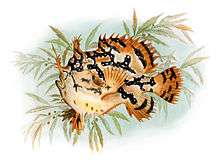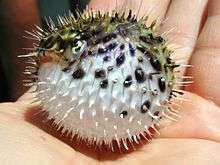Sargassum
| Sargassum | |
|---|---|
 | |
| Scientific classification | |
| Domain: | Eukaryota |
| (unranked): | SAR |
| Superphylum: | Heterokonta |
| Class: | Phaeophyceae |
| Order: | Fucales |
| Family: | Sargassaceae |
| Genus: | Sargassum |
| Species | |
| |


Sargassum is a genus of brown (class Phaeophyceae) macroalgae (seaweed) in the order Fucales. Numerous species are distributed throughout the temperate and tropical oceans of the world, where they generally inhabit shallow water and coral reefs, and the genus is widely known for its planktonic (free-floating) species. While most species within the class Phaeophyceae are predominantly cold water organisms that benefit from nutrients upwelling, genus Sargassum appears to be an exception to this general rule.[1] Any number of the normally benthic species may take on a planktonic, often pelagic existence after being removed from reefs during rough weather; however, two species (S. natans and S. fluitans) have become holopelagic—reproducing vegetatively and never attaching to the seafloor during their lifecycle. The Atlantic Ocean's Sargasso Sea was named after the algae, as it hosts a large amount of sargassum.[2]
History
Sargassum was named by the Portuguese sailors who found it in the Sargasso Sea after a species of rock rose (Helianthemum) that grew in their water wells at home and that was called sargaço in Portuguese (Portuguese pronunciation: [sɐɾˈɣasu]).[3]
The Florida Keys and its smaller islands are well known for their high levels of Sargassum covering their shores. Gulfweed was observed by Columbus. Although it was formerly thought to cover the entirety of the Sargasso Sea, making navigation impossible, it has since been found to occur only in drifts.[4]
Sargassum is also cultivated and cleaned for use as an herbal remedy. Many Chinese herbalists prescribe powdered Sargassum, either the species S. pallidum, or more rarely, hijiki, S. fusiforme, in doses of 0.5 gram, to be dissolved in warm water and drunk as a tea. It is called "hai zao" in Traditional Chinese Medicine, where it is used to resolve "heat phlegm."[5]
Description
Species of this genus of algae may grow to a length of several metres. They are generally brown or dark green in color and consist of a holdfast, a stipe, and a frond. Oogonia and antheridia occur in conceptacles embedded in receptacles on special branches.[6] Some species have berrylike gas-filled bladders which help keep the fronds afloat to promote photosynthesis. Many have a rough sticky texture, which together with a robust but flexible body, helps it to withstand strong water currents.
Ecology
The thick masses of Sargassum provide an environment for a distinctive and specialised group of marine animals and plants, many of which are not found elsewhere.
Sargassum is commonly found in the beach drift near Sargassum beds where they are also known as gulfweed, a term also used to include all seaweed species washed up on shore.
Sargassum species are found throughout tropical areas of the world and are often the most obvious macrophyte in near-shore areas where Sargassum beds often occur near coral reefs. The plants grow subtidally and attach to coral, rocks or shells in moderately exposed or sheltered rocky or pebble areas. These tropical populations often undergo seasonal cycles of growth and decay in concert with seasonal changes in sea temperature.[7] In some cases (e.g., the Sargasso Sea) there are floating populations of Sargassum.
In tropical Sargassum species that are often preferentially consumed by herbivorous fishes and echinoids, there is a relatively low level of phenolics and tannins.[8]



Some other small fish, such as this juvenile puffer (right), are also found in sargassum.
Sargassum muticum
Sargassum muticum is a large brown seaweed of the class Phaeophyceae.[9] It grows attached to rocks by a perennial holdfast up to 5 cm in diameter. From this holdfast the main axis grows to a maximum of 5 cm high. The leaf-like laminae and primary lateral branches grow from this stipe. In warm waters it can grow to 12 m long, however in British waters it gives rise to a single main axis with secondary and tertiary branches which are shed annually. Numerous small 2–6 mm stalked air vesicles provide buoyancy. The reproductive receptacles are also stalked and develop in the axils of leafy laminae. It is self-fertile.
Distribution
South coast of England and several sites in the south of Ireland.[9]
Sargassum adrift in Gulf Stream
The Gulf has the second largest concentration of sargassum of any body of water in the world. A fair amount of it washes out through the Straits of Florida in the Gulf Stream and ends up in the Sargasso Sea in the Atlantic Ocean off the East Coast of the United States.[10]
We rounded Hatteras in fair weather, and saw the line between the brilliant blue Gulf Stream full of gulf weed and the muddy grayish shore water as clearly defined as that between the sidewalk and the roadway in a street.[11]
Sargassum crisis in the Caribbean Sea
In the summer of 2015, large quantities of different species of Sargassum accumulated along the shores of many of the countries bathed by the Caribbean Sea. Some of the affected islands and regions include the Caribbean coast of Mexico, the Dominican Republic, Barbados and Tobago[12] The aquatic plant washes ashore, piles up on beaches, and decays, often causing a foul odor. The affected countries and territories are discussing causes of the outbreak, potential solutions, and the negative affects on tourism.[13] Researchers say that the Sargassum outbreak started in 2011, but it has become worse over the years. There are several factors that could explain the proliferation of Sargassum in the area in recent years. These include the rise of sea temperature and the change of sea currents due to climate change. Also, nutriments from agricultural fertilizers and wastewater from the cities, that end up in the sea, could also make the algae bloom.[12]
See also
References
- ↑ C.Michael Hogan. 2011. Brown algae. eds. E.Monosson & C.J.Cleveland. Encyclopedia of Earth. National Council for Science and the Environment. Washington DC
- ↑ "Sargasso". Straight Dope.
- ↑ Gómez de Silva, Guido 1988. Breve diccionario etimológico de la lengua española. Fondo de Cultura Económica, Mexico City, ISBN 968-16-2812-8, p. 627.
- ↑ David McFadden (August 10, 2015). "Stinking mats of seaweed piling up on Caribbean beaches". Retrieved August 10, 2015.
- ↑ Xu Li & Wang Wei (2002). Chinese Materia Medica: Combinations and Applications. Donica Publishing Ltd. p. 425. ISBN 1-901149-02-1.
- ↑ Abbott, I.A. and Hollenberg, G.J. 1976. Marine Algae of California. Stanford University
- ↑ Fulton CJ, Depczynski M, Holmes TH, Noble MM, Radford B, Wernberg TH, Wilson SK (2014) Sea temperature shapes seasonal fluctuations in seaweed biomass within the Ningaloo coral reef ecosystem. Limnology & Oceanography 59, 156-166. http://ningaloo-atlas.org.au/content/sea-temperature-drives-seasonal-cycles-ningaloo-seaw
- ↑ Chemical defenses and the susceptibility of tropical marine brown algae to herbivores. Peter D. Steinberg, Oecologia, 1986, Volume 69, Number 4, pages 628-630, doi:10.1007/BF00410374
- 1 2 Hardy, F.G. and Guiry, M.D. 2003. A Check-list and Atlas of the Seaweeds of Britain and Ireland. The British Phycological Society. ISBN 0-9527115-16
- ↑ Bob Shipp interviewed by Jeff Young (16 July 2010). "Living on Earth: The Need for Seaweed". PRI's Environmental News Magazine.
- ↑ Pinchot, Gifford (1930). To the South Seas. New York City: Blue Ribbon Books. p. 14.
- 1 2 "Stinking seaweed piling high on beaches in tourism-dependent Caribbean". CBC News.
- ↑ "Sargassum seaweed, 'greatest single threat to the Caribbean tourism industry'". MercoPress.
Further reading
- Critchley, A.T., Farnham, W.F. and Morrell, S.L. 1983. A chronology of new European sites of attachment for the invasive brown alga, Sargassum muticum, 1973 - 1981. Journal of the Marine Biological Association of the United Kingdom, 63: 799 - 811.
- Boaden, P.J.S. 1995. The adventive seaweed Sargassum muticum (Yendo) Fensholt in Strangford Lough, Northern Ireland. Ir. Nat. J. 25 111 - 113.
- Davison, D.M. 1999. Sargassum muticum in Strangford Lough, 1995–1998; a review of the introduction and colonisation of Strangford Lough MNR and cSAC by the invasive brown alga Sargassum muticum. Environment and Heritage Service Research and Development Series. No.99/27 ISSN 1367-1979.
External links
| Wikimedia Commons has media related to Sargassum. |
| Wikisource has the text of the 1920 Encyclopedia Americana article Sargassum. |
- algaebase.org
- seaweed.ie
- marlin.ac.uk
- Sargassum in Northern Ireland.
- The SuriaLink Seaplants Handbook - Sargassum
- habitas.org.uk
- irishseaweed.com
- Sargassum reproduction.
- Sargassum Early Advisory System Texas